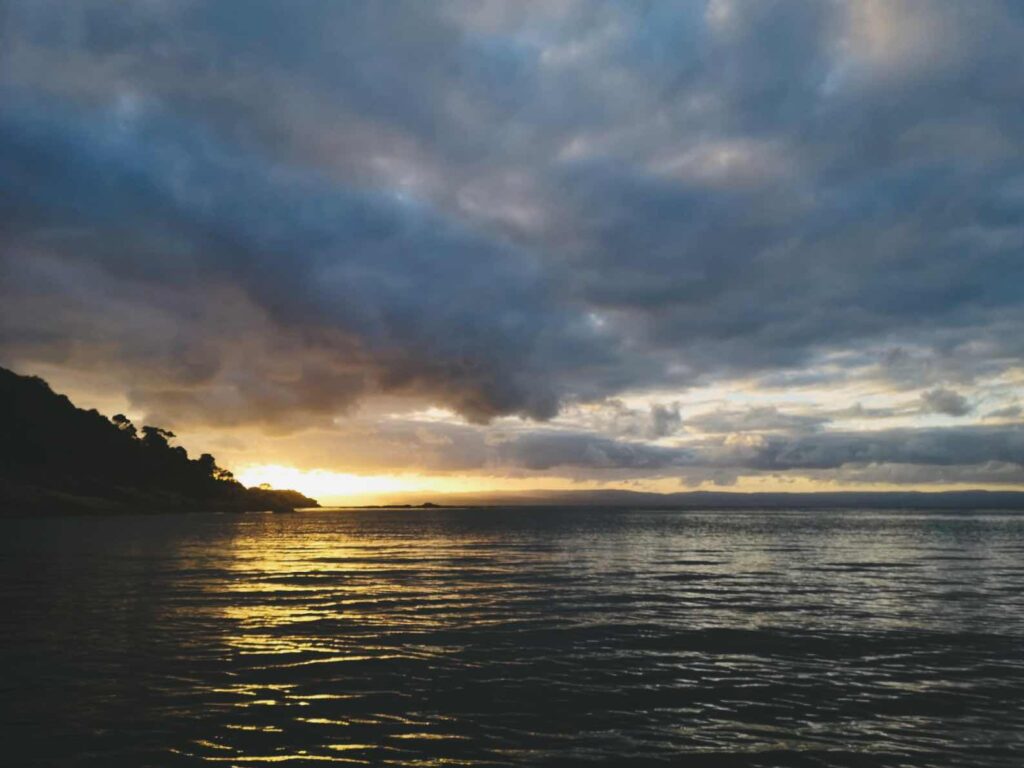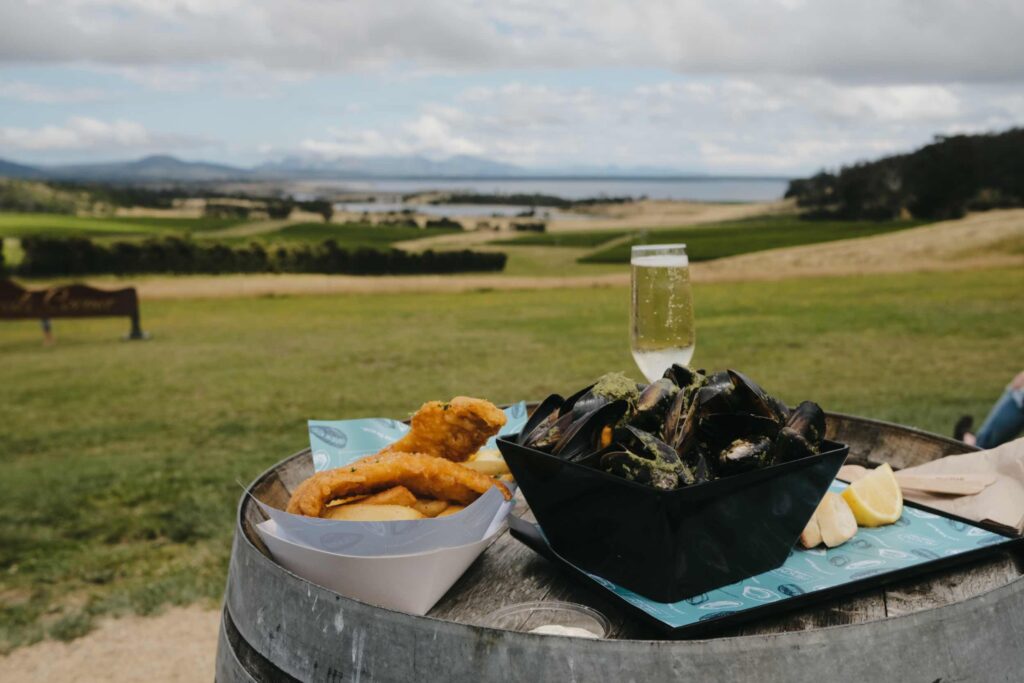Heading East out of Hobart, the buildings soon gave way to some of the most beautiful landscapes we’ve seen in Australia. Endless rolling green hills in every direction feel more like Scotland than an island in the Southern Hemisphere. Freycinet National Park is located on a peninsula on the East coast of Tasmania. Home to granite peaks, Freycinet’s crystal clear, cold and nutrient filled waters make for some of the finest oysters and lobster in Australia.
Spending 2 nights in Freycinet allowed us just enough time to squeeze in everything we had planned with a day in the middle full to the brim with activities.
We arrived at Coles Bay in the early evening following a two and a half hour drive from Hobart, obviously stopping at various wineries along the way to sample some local sips. Coles bay is a small village on the edge of the National Park and as such has a small general store, perfect for basic provisions though you might be better stopping off at a bigger town such as Bicheno or even all the way back in Hobart to do a grocery shop. We decided to head further up the road to the rather cheesily named Honeymoon Bay. The clear waters were too good to resist, prompting a quick dip in the beautiful sheltered bay bathed in golden evening light with the backdrop of the Hazards Mountains.

The next morning we ventured into the National Park to walk the popular Hazards Beach – Wineglass Bay circuit. After considering the more challenging hike up Mt Amos, we decided against it after recently getting lost in NSW’s Blue Mountains for 5 hours in 30 degree heat. The loop starts off with an uphill hike to the stunning Wineglass Bay lookout before descending onto the white sandy beach and beautiful calm waters of the bay. The walk across the isthmus brought us to the windswept Hazards Beach. Strewn with drift wood and grey skies coming in, it felt more like the Cornish coastline. The rest of the walk wound up and down through bushland and along the base of Mt Mayson back to the car park. To top off the decidedly Cornish feel to our Tasmanian morning we stopped off at Freycinet Lodge for a cream tea sat out looking over the bay.
Next on the agenda for our day of activities was the Oyster Bay Tour which promised waders, learning how to shuck an oyster, and a glass of Riesling. With the assistance of our witty tour guide we were kitted out in our waders and trudged out to the oyster cages. Here we learned all about the life cycle of the oyster, were shown oysters throughout their life from tiny babies to oysters bigger than your palm which iif left, can grow up to a meter in length! We also got to try the freshest oysters we’ll ever eat, straight out of the ocean, shucked, and into our mouths – salty sea water and all. We headed back to shore and stood around barrels with a glass of local Freycinet Vineyard Riesling, a dozen oysters and a bowl of steaming hot mussels. After our quick tutorial on the anatomy and best way to shuck the oyster, (tip: not from the back and into the hinge of the shell, rather in through the side to cut the adductor muscle to allow it to pop open), we went at them. Surprisingly easy and with no fingers lost we soon had a dozen shucked oysters complete with a punchy red wine vinegar mignonette ready to tuck in. The Riesling was the perfect partner to wash all the shellfish down – dry in style with bracing lime acidity with a beautifully fragrant lychee and floral nose which helped match the salinity of the oyster, the acidity of the mignonette and the creaminess of the steamed mussels. As a bonus, we helped ourselves to a bunch of salty, juicy samphire growing wild on the waters edge to go with our Tassie salmon for dinner.
To finish off the day we booked in for a kayak tour in Cole’s Bay. After a blustery rainy day we were a little apprehensive for an evening on the water. Luckily the wind dropped and the sun came out just in time. The group was small which allowed us to have a chat with most people including a fellow British medic expat on a trip from Melbourne. The tour guides taught us about the traditional custodians of the land and their respectful land and hunting practices that allowed them to co-exist with their environment for thousands of years. We learned about the many lives of the Bay as a whaling centre, its mining history in the 1930s by Italian immigrants exporting the unique pink granite rumoured to grace the Empire State Building and the somewhat cursed history of Freycinet Lodge. Following this we pulled into a small bay and were refreshed with some hot chocolate and cookies before heading back before dark. Being out in the evening meant we were lucky enough to experience a beautiful sunset over the water, an experience I will be sure to remember for a long time to come. We finished off our day with some a dozen Oyster Bay oysters, simply cooked Tassie salmon with our ‘foraged’ samphire and a bottle of crisp, fragrant Devil’s Corner Riesling.

We visited two wineries during our trip to Freycinet – Devil’s Corner and Freycinet Vineyard. Devil’s Corner certainly being the larger of the two vineyards comes with a cellar door, two food outlets and a lookout point. We went at lunch time and tucked into a bowl of mussels cooked in white wine and herby salsa verde and freshly cooked fish and chips, all washed down with a glass of bubbles. Their sparkling is a pinot noir/chardonnay blend made in the traditional method, tasting fresh and young with only the slightest hint of brioche notes, making it an easy drinking accompaniment to both the mussels and battered fish.

Freycinet Vineyard located just off the Tasman Highway is a much smaller set up. We were the only people there on a midweek morning. We were thoughtfully taken through their selection which included the Tassie typical varieties of Riesling, Chardonnay and Pinot Noir as well as a Sauvignon Blanc, Cabernet Sauvignon/Merlot blend and a Sauvignon Blanc Botrytis. With multiple styles for their chardonnay, riesling and pinot noir, our favourite being a minerally Chablis style chardonnay, there is likely to be a something to your taste all with the backbone of cool climate Tassie typicity.





